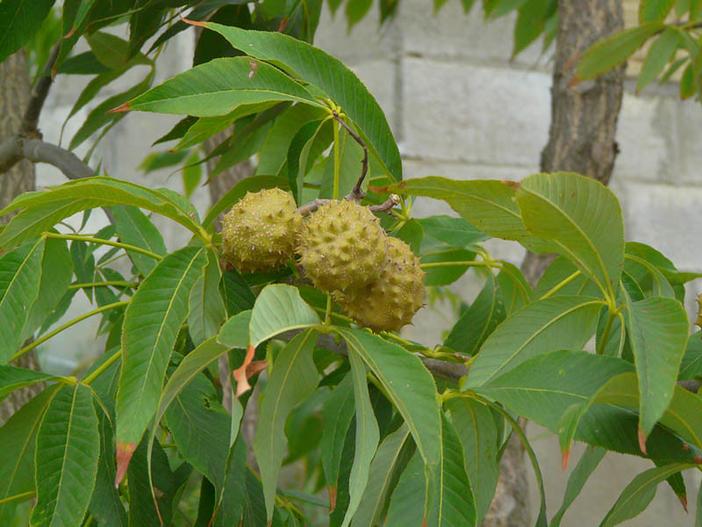Ohio Buckeye
(Aesculus glabra)
Ohio Buckeye (Aesculus glabra)
/
/

Radu Chibzii
CC BY-SA 2.0
Image By:
Radu Chibzii
Recorded By:
Copyright:
CC BY-SA 2.0
Copyright Notice:
Photo by: Radu Chibzii | License Type: CC BY-SA 2.0 | License URL: https://creativecommons.org/licenses/by-sa/2.0/ | Uploader: Radu Chibzii | Publisher: Flickr























































































Estimated Native Range
Summary
Aesculus glabra, commonly known as Ohio Buckeye, is a deciduous tree native to rich bottomlands, floodplains, and mesic hardwood forests of the Midwestern and lower Great Plains regions of the United States, as well as the geological Black Belt of Alabama and Mississippi. It is also found in the extreme southwest of Ontario, on Walpole Island in Lake St. Clair. Ohio Buckeye typically grows to a height of 20-40 feet (6-12 meters) with a similar spread, and is recognized by its palmately compound leaves and erect panicles of yellow-green flowers that bloom in spring. The tree produces large, round, inedible seeds encased in a thick, leathery husk that resemble the eyes of a deer, hence the common name.
Ohio Buckeye is valued for its ornamental features, including the showy flowers and the rich, green foliage that turns yellow in the fall. It is used in residential landscapes, parks, and naturalized areas. The tree prefers full sun to part shade and grows best in moist, well-drained soils. It is relatively low-maintenance but can suffer from leaf blotch, powdery mildew, and other foliar diseases. The tree’s large seeds and toxicity make it less suitable for street planting. Ohio Buckeye is not typically invasive in its native range but can be problematic elsewhere; it is important to consult local guidelines before planting.CC BY-SA 4.0
Ohio Buckeye is valued for its ornamental features, including the showy flowers and the rich, green foliage that turns yellow in the fall. It is used in residential landscapes, parks, and naturalized areas. The tree prefers full sun to part shade and grows best in moist, well-drained soils. It is relatively low-maintenance but can suffer from leaf blotch, powdery mildew, and other foliar diseases. The tree’s large seeds and toxicity make it less suitable for street planting. Ohio Buckeye is not typically invasive in its native range but can be problematic elsewhere; it is important to consult local guidelines before planting.CC BY-SA 4.0
Plant Description
- Plant Type: Tree
- Height: 20-40 feet
- Width: 20-40 feet
- Growth Rate: Moderate
- Flower Color: Yellow
- Flowering Season: Spring
- Leaf Retention: Deciduous
Growth Requirements
- Sun: Full Sun, Part Shade
- Water: Medium
- Drainage: Medium, Slow
Common Uses
Bee Garden, Bird Garden, Butterfly Garden, Deer Resistant, Drought Tolerant, Fire Resistant, Fragrant, Hummingbird Garden, Rabbit Resistant, Salt Tolerant, Showy Flowers
Natural Habitat
Rich bottomlands, floodplains, and mesic hardwood forests
Other Names
Common Names: Texas Buckeye, Fetid Buckeye, Marronnier Glabre
Scientific Names: , Aesculus glabra, Aesculus carnea, Aesculus glabra var. leucodermis, Aesculus glabra var. sargentii, Aesculus ohioensis, Aesculus pallida, Aesculus ×plantierensis, Aesculus glabra var. monticola, Aesculus ×carnea var. briotii
GBIF Accepted Name: Aesculus glabra Willd.